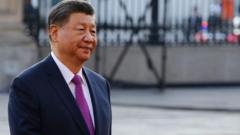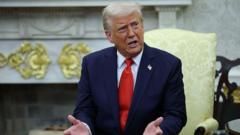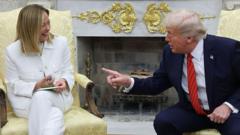**The ongoing trade war raises questions about the future economic landscape and potential repercussions for global markets.**
**China Stands Firm Against Trump’s Tariff Strategy: Implications Ahead**

**China Stands Firm Against Trump’s Tariff Strategy: Implications Ahead**
**As the US-China trade conflict escalates, economic repercussions loom for both nations.**
China has firmly declared its resolve in the ongoing trade conflict with the US, with no signs of backing down despite President Trump's threats to escalate tariffs significantly. In a stark warning, the US President indicated that the tariffs on Chinese goods could reach a staggering 104%, putting at risk a myriad of products ranging from electronics to essential consumer goods. As this diplomatic standoff continues, both nations refuse to give ground, raising the stakes for economies around the world.
Economist Alfredo Montufar-Helu emphasizes that expecting China to cede its position would not only portray weakness but also grant the US further leverage to impose additional demands. Analysts have noted a concerning deadlock, suggesting a prolonged period of economic distress could ensue as both sides engage in tit-for-tat tariff measures. Since last week, global markets have reacted negatively, mirroring the heightened tensions between these two economic powerhouses.
Following Trump's initial tariffs, China retaliated with its own punitive measures affecting US imports and has now adjusted its currency strategy, allowing the yuan to weaken, boosting the competitiveness of its exports. In a landscape marked by uncertainty, both nations are immersed in a strategic contest over who can absorb more economic pain without blinking first.
Despite facing its own economic challenges—including a sluggish property market and rising unemployment—China remains undeterred in its stance against US aggression. Notably, experts warn that these tariffs could exacerbate existing issues within China's economy, impacting its export-dependent growth model.
Simultaneously, the US grapples with finding alternatives to replacing the substantial volume of imports it sources from China, which amounted to $438 billion in 2024. The intertwined nature of both economies means that the repercussions of tariffs will likely extend beyond trade barriers, affecting investment flows and digital exchanges.
Observers are keenly aware of the broader international implications. As Chinese products potentially redirected away from the US, nearby markets, particularly in Southeast Asia, may become the next battleground for these economic titans, each navigating their complicated situations amid rising global trade tensions.
The path forward remains obscured; experts hint at the potential for private negotiations whereas others remain skeptical of the US's assumptions about its market leverage. As tensions heighten, the ultimate outcome of this trade war is far from clear, leaving analysts pondering the rapid escalatory tendencies at play and the potentially severe consequences for global economic stability.
Economist Alfredo Montufar-Helu emphasizes that expecting China to cede its position would not only portray weakness but also grant the US further leverage to impose additional demands. Analysts have noted a concerning deadlock, suggesting a prolonged period of economic distress could ensue as both sides engage in tit-for-tat tariff measures. Since last week, global markets have reacted negatively, mirroring the heightened tensions between these two economic powerhouses.
Following Trump's initial tariffs, China retaliated with its own punitive measures affecting US imports and has now adjusted its currency strategy, allowing the yuan to weaken, boosting the competitiveness of its exports. In a landscape marked by uncertainty, both nations are immersed in a strategic contest over who can absorb more economic pain without blinking first.
Despite facing its own economic challenges—including a sluggish property market and rising unemployment—China remains undeterred in its stance against US aggression. Notably, experts warn that these tariffs could exacerbate existing issues within China's economy, impacting its export-dependent growth model.
Simultaneously, the US grapples with finding alternatives to replacing the substantial volume of imports it sources from China, which amounted to $438 billion in 2024. The intertwined nature of both economies means that the repercussions of tariffs will likely extend beyond trade barriers, affecting investment flows and digital exchanges.
Observers are keenly aware of the broader international implications. As Chinese products potentially redirected away from the US, nearby markets, particularly in Southeast Asia, may become the next battleground for these economic titans, each navigating their complicated situations amid rising global trade tensions.
The path forward remains obscured; experts hint at the potential for private negotiations whereas others remain skeptical of the US's assumptions about its market leverage. As tensions heighten, the ultimate outcome of this trade war is far from clear, leaving analysts pondering the rapid escalatory tendencies at play and the potentially severe consequences for global economic stability.





















